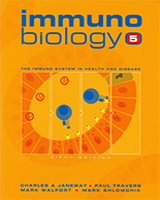By agreement with the publisher, this book is accessible by the search feature, but cannot be browsed.
NCBI Bookshelf. A service of the National Library of Medicine, National Institutes of Health.
Janeway CA Jr, Travers P, Walport M, et al. Immunobiology: The Immune System in Health and Disease. 5th edition. New York: Garland Science; 2001.

Immunobiology: The Immune System in Health and Disease. 5th edition.
Show detailsThe antigen receptors on T cells recognize complexes of pathogen-derived peptides bound to MHC molecules on a target cell surface. There are two classes of MHC molecule—MHC class I molecules, which bind stably to peptides derived from proteins synthesized and degraded in the cytosol, and MHC class II molecules, which bind stably to peptides derived from proteins degraded in endocytic vesicles. In addition to being bound by the T-cell receptor, the two classes of MHC molecule are differentially recognized by the two co-receptor molecules, CD8 and CD4, which characterize the two major subsets of T cells. CD8 T cells recognize MHC class I:peptide complexes and are activated to kill cells displaying foreign peptides derived from cytosolic pathogens, such as viruses. CD4 T cells recognize MHC class II:peptide complexes and are specialized to activate other immune effector cells, for example B cells or macrophages, to act against the foreign antigens or pathogens that they have taken up. Thus, the two classes of MHC molecule deliver peptides from different cellular compartments to the cell surface, where they are recognized by different types of T cells that carry out the appropriate effector function. There are several genes for each class of MHC molecule, arranged in clusters within a larger region known as the major histocompatibility complex (MHC). Within the MHC, the genes for the MHC molecules are closely linked to genes involved in the degradation of proteins into peptides, the formation of the complex of peptide and MHC molecule, and the transport of these complexes to the cell surface. Because the several different genes for the MHC class I and class II molecules are highly polymorphic and are expressed in a codominant fashion, each individual expresses a number of different MHC class I and class II molecules. Each different MHC molecule can bind stably to a range of different peptides, and thus the MHC repertoire of each individual can recognize and bind many different peptide antigens. Because the T-cell receptor binds a combined peptide:MHC ligand, T cells show MHC-restricted antigen recognition, such that a given T cell is specific for a particular peptide bound to a particular MHC molecule. The genes encoding the T-cell receptors appear to have evolved to recognize MHC molecules, thus accounting for the high frequency of T cells that respond to allogeneic MHC molecules, such as those on an organ transplant from an unrelated donor.
- Summary to Chapter 5 - ImmunobiologySummary to Chapter 5 - Immunobiology
Your browsing activity is empty.
Activity recording is turned off.
See more...